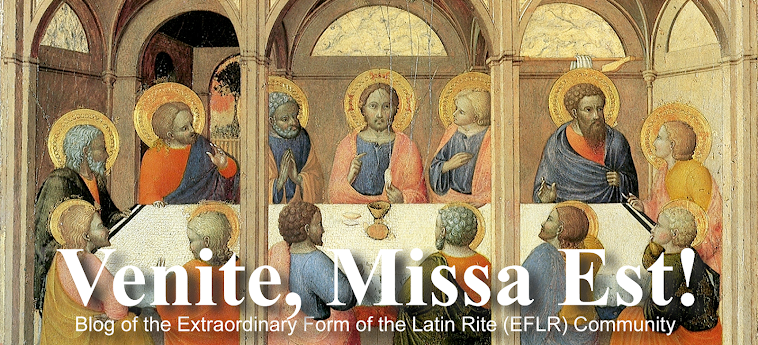Topics: Feast Day: St. Juan Diego
There's more news on the website:
http://venite-missa-est.blogspot.com and video you cannot see from the email newsletter. If you receive by email be sure and check out the site to get every bit of the information from Venite, including pictures, video, links and more. Here's the link:
http://venite-missa-est.blogspot.com/
@@@@@@@@@@@@@@@
The Necessaries.
I am a member of the Latin Mass Community of St. Anthony Parish,Wichita, Ks. I also assist at low mass at, St. Mary Parish, Newton, Ks. While this blog may at times comment on, or allude to, a community or parish, Venite Missa Est! is by no means, in any way an official voice of any particular parish or the Diocese of Wichita. Venite Missa Est! is strictly a private layman's endeavor.
Mass Schedules for December
For St. Mary Parish, Newton, Ks. there is no Latin Mass this Saturday, December 12th. No mass this coming Saturday. Saturday mass will resume.
Saturday, December 12th, is the Feast of Our Lady of Guadalupe. It is not a day of obligation. There is no Traditional Latin Mass planned. This Saturday's Latin Mass at St. Mary Newton is cancelled due to a heavy schedule with Fr. Voelker.
The first mass of Christmas will be: Midnight Mass December 25 . Christmas carols will be sung at 11:30 p.m. (Christmas Eve) with mass starting at midnight. This mass is at St. Anthony Parish, Second and Ohio, approximately 6 blocks west of the canal route, two blocks East of Old town.
My Catholic brothers. Come worship as the Saints did. Come worship as your parents, grandparents and their ancestors did stretching back into history. It is your heritage.
Feast of St. Juan Diego, December 9
St. Juan Diego
(1474-1548)
American Catholic
Bloggers note: A very old picture of a painting of Juan Diego had hung in my parents home and now hangs in mine so St. Diego holds a special place in my heart. He was poor, uneducated and simple but with undying love and faith for God.
Thousands of people gathered in the Basilica of Our Lady of Guadalupe July 31, 2002, for the canonization of Juan Diego, to whom the Blessed Mother appeared in the 16th century. Pope John Paul II celebrated the ceremony at which the poor Indian peasant became the Church’s first saint indigenous to the Americas.
The Holy Father called the new saint “a simple, humble Indian” who accepted Christianity without giving up his identity as an Indian. “In praising the Indian Juan Diego, I want to express to all of you the closeness of the church and the pope, embracing you with love and encouraging you to overcome with hope the difficult times you are going through,” John Paul said. Among the thousands present for the event were members of Mexico’s 64 indigenous groups.
First called Cuauhtlatohuac (“The eagle who speaks”), Juan Diego’s name is forever linked with Our Lady of Guadalupe because it was to him that she first appeared at Tepeyac hill on December 9, 1531. The most famous part of his story is told in connection with the Feast of Our Lady of Guadalupe (December 12). After the roses gathered in his tilma were transformed into the miraculous image of Our Lady of Guadalupe, however, little more is said about Juan Diego.
In time he lived near the shrine constructed at Tepeyac, revered as a holy, unselfish and compassionate catechist who taught by word and especially by example.
During his 1990 pastoral visit to Mexico, Pope John Paul II confirmed the long-standing liturgical cult in honor of Juan Diego, beatifying him. Twelve years later he was proclaimed a saint.
Comment:
God counted on Juan Diego to play a humble yet huge role in bringing the Good News to the peoples of Mexico. Overcoming his own fear and the doubts of Bishop Juan de Zumarraga, Juan Diego cooperated with God’s grace in showing his people that the Good News of Jesus is for everyone. Pope John Paul II used the occasion of this beatification to urge Mexican lay men and women to assume their responsibilities for passing on the Good News and witnessing to it.
Quote:
“Similar to ancient biblical personages who were collective representations of all the people, we could say that Juan Diego represents all the indigenous peoples who accepted the Gospel of Jesus, thanks to the maternal aid of Mary, who is always inseparable from the manifestation of her Son and the spread of the Church, as was her presence among the Apostles on the day of Pentecost” (Pope John Paul II, beatification homily).




